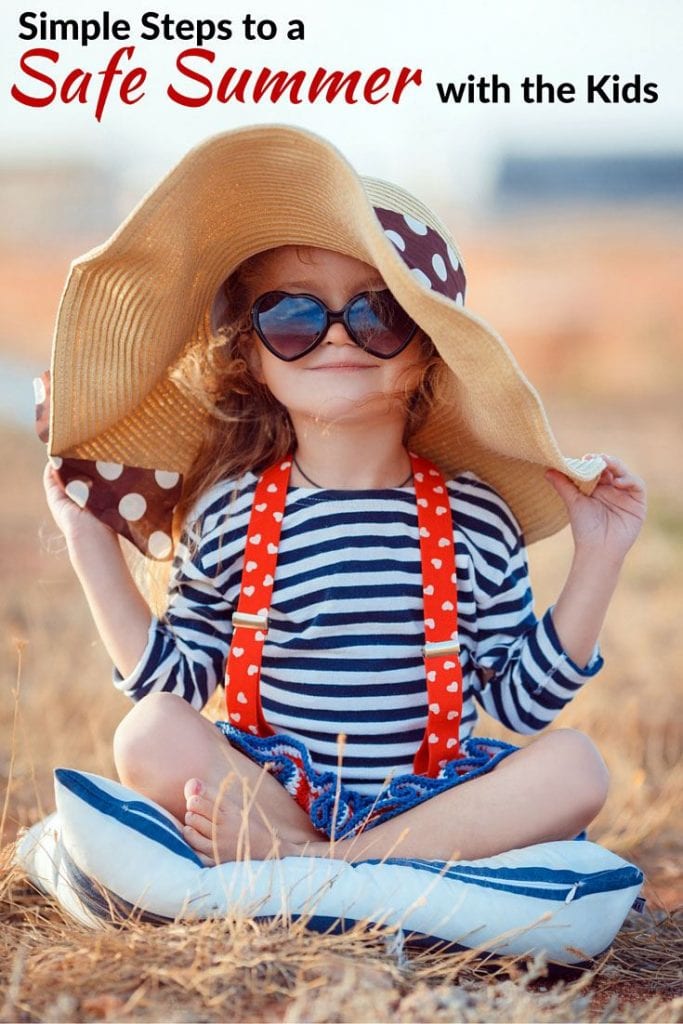<<< Guest Post by Jennifer Taylor >>>
It’s summertime and the warm weather is calling everyone outdoors!
I don’t know about you, but spending the majority of my time indoors with my family for the past six months makes me welcome the warmth of summer with open arms.
Although we brave the winter elements and enjoy skating and tobogganing, the cold temperatures can make the outdoors downright dangerous.
The warm weather and sunshine is glorious, but it can fool us into a false sense of security. As parents, we can’t let our guards down. Summer has its own set of dangers and we need to be prepared at all times. As you prepare for your summer outings and camping trips, here are some important things to keep in mind.
Sun Protection
Young children are especially prone to skin damage from the sun. The younger the skin, the more sensitive it is to the sun.
Pediatricians now say it is safe to put small amounts of sunscreen (like these) on babies under the age of 6 months. I always look for a sunscreen that has zinc in it. This kind of sunscreen sits on top of the skin rather than being absorbed.
Prevention is still the best way to go. That means:
- wearing wide-brimmed hats that shade ears, necks and faces,
- dressing in light-colored, loose-fitting clothing,
- avoid being in direct sunlight between 10 am and 2 pm.
No matter how much we try to protect our children’s delicate skin, sunburns can occur. I have found the best way to soothe overexposed skin is with Aloe Vera gel. Smooth it on several times a day until the redness subsides.
Strollers now have covers with UV protection that protect young riders from bugs and sun. They are available at most stores that sell strollers.
Dehydration & Heat Exhaustion
Being in the hot sun has another danger: dehydration and heat exhaustion. This is especially common in young children who don’t tolerate heat as well as adults.
Prevention is once again the key here. Have your children drink plenty of fluids beginning first thing in the morning!
Last summer, one of my kids almost passed out. He suddenly became pale and he felt nauseous and weak. After realizing that he had eaten breakfast and a snack but had not had anything to drink, I quickly realized what the problem was! With fluids and rest, he felt better within half an hour.
Younger children and babies can’t always communicate with us. It is our responsibility to ensure that they drink fluids and that we bring appropriate liquids with us when we leave the house. Encourage your little ones to take water breaks often.
• • • Grab our favorite kid’s water bottle • • •
A dehydrated child will appear to be tired and uninterested. They may also appear to be uncoordinated. Watch for rapid breathing and a sunken soft spot in young infants. If you see these signs, quickly move the child to a cool area and encourage them to drink plenty of liquid.
One last thing. Never, ever leave your child unattended in a vehicle. I think that goes without saying, but it never hurts it be reminded one more time.
Bugs & Bug Sprays
If you are not a fan of using bug sprays like I am, the best thing you can do is avoid mosquito bites by wearing light-colored, loose-fitting clothes. There are many folktales about alternative bug repellents (like Bounce laundry sheets), but they’ve never worked for us. I usually end up using bug spray when the mosquitoes are unbearable.
I feel better about using bug spray by putting most of it on clothes and hats and spraying lightly on exposed skin. There are speciality bug sprays just for clothes that you can try.
A new product to look for is bug spray wipes. You can dab them carefully on children’s faces and arms without them inhaling any of it.
One more thing – did you know that insects are attracted to perfumey smells? Try to avoid scented products if you’re spending time outside.
Ticks
I’m surprised where ticks have been found this summer. It doesn’t matter if you live in the city, you can still pick up a tick.
Check children frequently for ticks. Double check their warm, dark places like diapers and underarms, because that’s where ticks like to hide.
If you find a tick, pull it off with your fingers and keep it in a ziplock bag if you suspect it has been on for more than a day. Wash the area well and check it daily for signs of the bullseye rash associated with Lyme disease. NOTE: the bullseye is just one sign of lime disease. A ring without a bullseye can also be a sign of a tick bite.
I have two friends whose children are now on antibiotics after the appearance of a bullseye rash. The good news is that they never got sick. Our job is to be vigilant with checking our children – both for ticks and for weird rashes.
Water Safety
Open bodies of water are one of the biggest dangers to young children. Drowning is the second leading cause of death in children under the age of 14. Begin teaching them water safety their first summer at the pool!
Even though my kids know, I remind them about proper water safety each time we’re at the pool or beach. My job is also to keep my young ones within arms reach. I also don’t let them get into the water before me.
• • • Our favorite life jacket for little ones • • •
A fun idea is to allow them to play lifeguard with a whistle for a few minutes so they can be the ones to call out unsafe behavior. Whenever possible and finances allow, start your kids in swim lessons as soon as possible.
In swimming pools, it’s especially important to do your part to make sure the water stays clean. Insist that your potty-trained kids use the toilet before they jump in the pool. Change swimming diapers frequently to avoid a literal dump. No one likes to sit by the poolside for two hours in the hot sun because of a spilled diaper or worse.
Know the Symptoms of Dry Drowning
Dry drowning occurs when a child inhales water accidentally. They may cough and sputter but then appear to be fine. If this happens, watch the child closely for lethargy. If they appear to be unusually tired and are having problems breathing within the next several hours (up to 24 hours), bring them to the hospital immediately. Water can wash away the surfactant in the lungs, making the lungs “stick” together when they exhale.
One Last Thing
Every child should have the opportunity to play outside as much as possible when the weather is nice. However, trips to the park can also include some dangers. Before you let your kids loose at the park, do a walk-through of the grounds and play structure. Look for broken glass, garbage that may tempt younger kids, animal waste, and broken playground equipment.
Prevention is always key when it comes to keeping our kids safe. I hope that I haven’t scared you into keeping your children inside all summer. Kids need to be outside, moving their bodies, exploring the world, and breathing fresh air.
Your goal is to be present with your kids. Put down your phones and be aware of the environment you’re in and the potential dangers that are possible. Prepare for the outdoor conditions and enjoy this summer with your kids!
Jennifer Taylor is the proud mama of two, a full-time puppy wrangler and part-time blogger at Mom Tricks.
Girl in striped shirt vertical and horizontal via ShutterStock.com



you shared very good article. these are problem that we faces in summer but we can recover with these.
Dust off your grill and grab your swimsuits, because the lazy days of summer are here!
This article is very helpful for parents. Thanks for sharing.